
- VAFS
DOI: https://doi.org/10.70169/VJFS.970
ISSN: 1859 - 0373
159
Nguyen Van Thanh1, Le Van Binh1, La Thi Bich Ngoc2
1Forest Protection Research Centre, Vietnamese Academy of Forest Sciences
2Northwestern University, Vietnam
Illicium verum is a non-timber forest product, which is widely cultivated in Vietnam. A leaf-feeder,
Pogonopygia nigralbata Warren is a moth (Lepidoptera: Geometridae: Ennominae), has caused significant
damage to plantations of this plant species in Bac Kan province. Field surveys in 2023 found P. nigralbata
damage to I. verum in the districts of Cho Moi and Bach Thong, with a damage incidence (P%) ranging from
33.7% to 69.5% and an average damage index (DI) from 0.75 to 1.72. The life cycle spans 69 - 96 days, with
overwintering occurring in the larval stage. Females lay 60 - 97 eggs during an oviposition period of 9 - 13 days.
The larval and pupal stages last 32 - 46 days and 23 - 30 days, respectively. Adults survive for 12 - 23 days, with
a longevity of 4 - 6 days. This pest should be researched in detail and included in future forest health monitoring
programs in Bac Kan to determine its suitable mangement approaches.
Keywords: Pogonopygia nigralbata, Illicium verum, star anise, morphology, identification, pest, symptom,
life cycle
MT S M SINH H C C Pogonopygia nigralbata Warren
(Lepidoptera: Geometridae: Ennominae) GÂY H I CÂY H I T I T NH B C K N
1 1 2
1
2
Cây H i (Illicium verum) là m t lo i lâm s n ngoài g có giá tr kinh t c gây tr ng r ng rãi t i nhi u
tnh c a Vi Pogonopygia nigralbata c ghi
nh n i nghiêm tr ng cho r ng tr ng loài cây này t i t nh B c K n. K t qu i
huy n Ch M i và B ch Thông cho th y t l b h i (P% ng t 33,7% - 69,5% và ch s b h i trung bình
(DI) t 0,75 - i c 69 - 96 ngày, v y ra pha sâu non.
t 60 - 97 tr ng, trong kho ng th i gian t 9 - n sâu non và nh ng l t
kéo dài t 32 - 46 ngày và t 23 - ng thành s ng t 12 - 23 ngày, v i tu i th t 4 - 6 ngày.
Loài sâu h i này c c nghiên c c
kh e r ng tr i t nh B c K xu n lý phù h p và hi u qu .
T khóa: Cây H i, Illicium verum Pogonopygia nigralbata nh, tri u ch ng,
i

Nguyen Van Thanh et al., 2024 4) 4
160
I. INTRODUCTION
The genus Illicium comprises 40 species
originating from tropical regions, mainly
Southeast Asia, the southeastern United States,
the Caribbean, and parts of Mexico. Five
species of Illicium are widely distributed
globally, including I. anisatum, I. arborescens,
I. henryi, I. lanceolatum, and I. verum. Most of
these species thrive in high mountainous areas
within the broadleaf forests of humid tropical
rainforests. This genus provides substantial
culinary, medicinal, ecological, ornamental, and
economic benefits, making it a valuable group
of plants with diverse applications. However,
various species of insects and diseases have
been reported to be serious pests of these
Illicium species. Notable pests include Dyscerus
hylobioides and Andromeda stephanitis in I.
anisatum (Inoue et al., 1997; Perley Spaulding,
1989; Williams & Wilkins, 2009),
Pseudodoniella sp. in I. verum, Aulacophora
femoralis in I. arborescens (Perley Spaulding,
1989), Agrotis ipsilon in I. henryi (Manuel,
2004), Oides leucomelaena and Dilophodes
elegans sincica in I. verum (Manuel, 2004).
Illicium verum is an aromatic evergreen tree
native to Southeast Asia. Its fruits, known as
star anise, are widely used in Chinese and
Vietnamese dishes (Wang et al., 2011). Apart
from its culinary applications, star anise is
valued for its medicinal properties in traditional
herbal remedies across various countries,
including China, Japan, Indonesia, Malaysia,
Mexico, Cuba, and the United States. It is
believed to alleviate symptoms such as
vomiting, stomach aches, insomnia, skin
inflammation, and rheumatic pain (Wang et al.,
2011). Additionally, the essential oil extracted
from star anise is traditionally employed to treat
rheumatism (Freire et al., 2011). Many principal
constituents of star anise have been isolated and
tested for fumigant toxicity and repellency
against insect pests and diseases (Zhou et al.,
2016; Matos et al., 2020), promising potential
application to the field of plant protection.
Due to the rapid and widespread expansion of
I. verum plantation areas in China and Vietnam,
this tree species has been facing significant
damage from insect pests and disease
infestations. For example, Pseudodoniella sp.
feeds on fruits and branch tips of its host,
resulting in the premature drop of flowers and
fruits as well as wilting branches (Yuelan et al.,
2004). Additionally, Zhao (2009) identified 10
insect pests and diseases infesting I. verum trees
in China. Because of high commercial values,
the Vietnamese government has encouraged
planting of these two tree species in economic
afforestation in Northern provinces of Vietnam,
including Bac Kan. The total estimated area of
I. verum plantations in the province in 2021 was
3,576 hectares. A previous study has reported a
list of 43 species of insect pests on I. verum
trees in Bac Kan province (Quang et al., 2022).
Pogonopygia nigralbata was considered among
the most dangerous pests and their widespread
is a concern to producers (Quang et al., 2022).
I. verum plantations in Bac Kan province have
been attacked heavily by the Pogonopygia
nigralbata leaf-feeders in recent years.
However, little is known about its
morphological identification and biological
characteristics. The primary objectives of this
study were to (i) provide the morphological
description of developmental phases, (ii)
quantify the extent of the damage, and (iii)
determine its life cycle. This information is
expected to assist local households and
government authorities in pest surveillance and

Nguyen Van Thanh et al.
161
in suitable management plan development for
this serious pest.
II. MATERIALS AND METHODS
2.1. Study sites and insect collection
Field observations were conducted in 2023 and
2024 in I. verum plantations of 14 - 25 - year -
old trees exhibiting Pogonopygia nigralbata
foliage damage in Cho Moi and Bac Thong
districts of Bac Kan province. Laboratory
studies of larvae were carried out at the Forest
Protection Research Centre (FPRC) of the
Vietnamese Academy of Forest Sciences in
Hanoi, Vietnam.
The infested I. verum plantations ranged from
15 to 35 hectares, with typical tree densities of
1,800 trees per hectare. Two age groups of trees
were selected for the study of foliage damage
across 10 plots in each district. Each plot,
measuring 500 m2, was randomly located within
the plantations. Foliage damage caused by P.
nigralbata larvae was recorded on 90 trees per
plot, with tree heights ranging from 120 to 150
cm. The last instar larvae of P. nigralbata were
reared on their host leaves until adults emerged.
Samples of P. nigralbata leaf-feeders obtained
as pupae from infested I. verum trees were
separated into petri dishes (9 × 1.5 cm) and
were maintained at 25°C (± 2°C) temperature, 65%
(± 5%) relative humidity, and a 12-hour
photoperiod until adult emergence.
2.2. Morphological characterization
The species were initially identified based on
the external morphological characteristics of 35
adult specimens (17 males and 18 females)
using the keys provided by Warren (1894).
Measurements of the immature stages (102
eggs, 67 larvae, and 91 pupae) were conducted
with a Leica M165C stereozoom microscope
(Leica Microsystem, Wetzlar, Germany)
equipped with a micrometric scale. The head
capsule width of larvae was measured as the
largest distance between the genae, while the
body length was measured from the frons to the
last abdominal segment. For pupal width, the
maximum width of the fourth abdominal
segment was used. Means and standard errors
were calculated for the measurements of these
specimens. Adult voucher specimens were
placed in the insect collection of the FPRC.
2.3. Damage assessment
Two field surveys for damage assessment were
conducted in Cho Moi and Bach Thong during
the specimen collection period. Thirty infested
I. verum trees were used to describe the damage
diagnostics. Five temporary plots, each measuring
1,000 m² (25 40 m), were established at each
site. The canopies of 30 randomly selected host
trees in each plot were assessed using binoculars.
Damage was classified into five levels: 0 = no
damage; 1 = leaf area loss < 25%; 2 = leaf area
loss 25 to < 50%; 3 = leaf area loss 50 to < 75%;
From the damage assessment results, the
damage incidence (P%) was calculated using
equation 1 (McMaugh, 2005):
P% = (n/N) × 100 (1)
Where: n is the number of trees defoliated by
P. nigralbata; N is the total number of
trees evaluated.
The average damage index (DI) in each plot
was calculated using equation 2 (Nguyen and
Dao, 2004):
i × vi)/N (2)
Where: ni is the number of defoliated trees at
damage index i;
vi is the damage index at level i;
N is the total number of trees evaluated.
The damage severity level was categorized
based on the average damage index as follows:
DI = 0,

Nguyen Van Thanh et al., 2024 4) 4
162
damage;
Data analysis was carried out using Microsoft
Office Excel software.
2.4. Observation of life cycle
In the laboratory, once P. nigralbata male and
female adults emerged from the pupae, they
were maintained in small, screened net cages of
standard size (60 × 40 × 40 cm). Newly
emerged adults were kept in these rearing cages
for 1 - 2 days, with honeybee solution provided
as food. After mating and oviposition, eggs
were collected on tissue paper and transferred to
petri dishes (9 × 1.5 cm) kept in acclimatized
chambers at 25oC (± 2oC) and 65% (± 5%)
humidity. Newly hatched larvae were then
reared individually in the laboratory using fresh
leaves of Illicium verum trees, and maintained
until they reached the adult stage again. The
branches with leaves were placed in a 0.5 L
glass bottle filled with water and changed
weekly to prevent the leaves from drying out.
Biological observations were made on the
duration of each developmental stage from egg
to adult, including the total lifespan in the
laboratory, as well as seasonally in the field.
III. RESULTS
3.1. Identification and characterization
Based on the external morphological description
of adults, eggs, larvae and pupae, Pogonopygia
nigralbata Warren (1894) infesting Illicium
verum trees in Cho Moi and Bac Thong
districts, Bac Kan provinces included the
following characteristics:
Adults (Fig. 1): Grayish white, prominently
marked with numerous black spots on the
wings; body length 22.5 ± 0.1 mm, forewing
length 63.4 ± 0.2 mm, hindwing length is 45.8
± 0.3 mm. Antennae are thread-like, compound
eyes are yellow brown. Thorax features many
black spots, surrounded by yellow-orange hair.
Abdomens have parallel rows of black spots,
with the rest of body being grayish white.
Forewings have evenly distributed black spots,
with a higher concentration along the outer
edges, while hindwings have black spots
concentrated at the edges and white near the
base, legs grayish white.
Eggs (Fig. 1): Grayish brown, oval; Eggs are
laid on the underside of leaves, not in clusters
but scattered; Each female lays 60 - 70 eggs.
Larvae (Fig. 1): Blackish gray; Head yellow-
brown and thorax is covered with numerous
black spots; Body has 5 pairs of legs, with the
first 3 pairs being yellow-brown and the last 2
pairs being grayish brown; Body length ranges
from 6.5 - 28.6 mm, and width ranges from 1.8 -
6.7 mm. The larvae of P. nigralbata passed
through five instars:
1st larval instar ranges from 6.5 - 14.7 mm in
length and 1.8 mm - 2.4 mm in width.
2nd larval instar ranges from 14.5 - 20.8 mm in
length and 2.5 - 3.4 mm in width.
3rd larval instar ranges from 21.2 - 24.9 mm in
length and 3.3 - 4.8 mm in width.
4th larval instar ranges from 24.8 - 27.2 mm in
length and 4.6 - 5.4 mm in width.
5th larval instar ranges from 26.8 - 29.6 mm in
length and 5.4 - 6.2 mm in width.
Pre-pupae (Fig. 1): Light gray; 22.4 - 25.2 mm
in length, and 4.3 - 5.1 mm in width, with
distinct segmentation.
Pupae (Fig. 1): Brown, 21.3 - 23.4 mm in
length, 4.5 - 5.0 mm in width; Head is larger,
and abdomen tapers gradually to the tail;
Abdomen consists of 5 segments, and the tail
has a spine.

Nguyen Van Thanh et al.
163
Figure 1. Morphological characteristics of Pogonopygia nigralbata:
1. Adult; 2. Egg; 3. 1st larva; 4. 2nd larva; 5. 3rd larva; 6. 4th larva; 7. 5th larva; 8. Pre-pupa; 9. Pupa
3.2. Pogonopygia nigralbata damage in
Illicium verum plantations
Pogonopygia nigralbata was found exclusively
on I. verum trees in plantation forests (Fig. 4).
The larvae of P. nigralbata consume the entire
leaf blade, starting from the edges and moving
toward the central vein, and from the leaf apex
down to the petiole. Severe infestations
sometime caused complete defoliation, and
consequently host trees died.
Figure 2. Damage symptoms of Pogonopygia nigralbata in Illicium verum foliage
in Bac Kan province

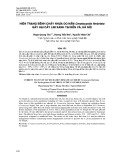
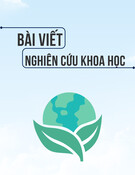
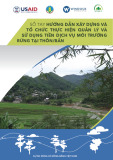
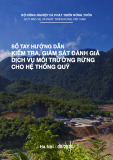
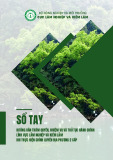

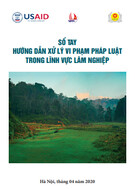
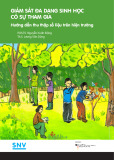



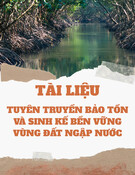
![Hỏi đáp pháp luật lâm nghiệp: Tài liệu [mới nhất/chuẩn nhất]](https://cdn.tailieu.vn/images/document/thumbnail/2025/20250711/vijiraiya/135x160/626_tai-lieu-hoi-dap-ve-phap-luat-lam-nghiep.jpg)



